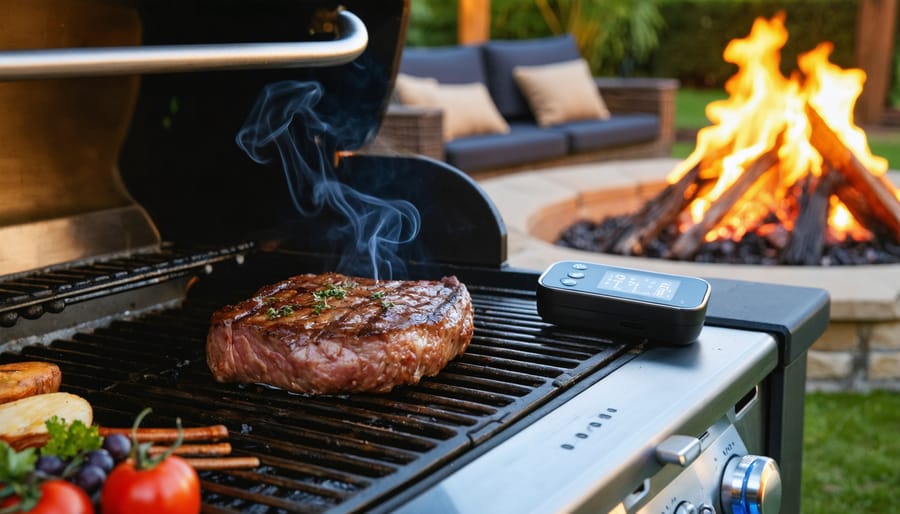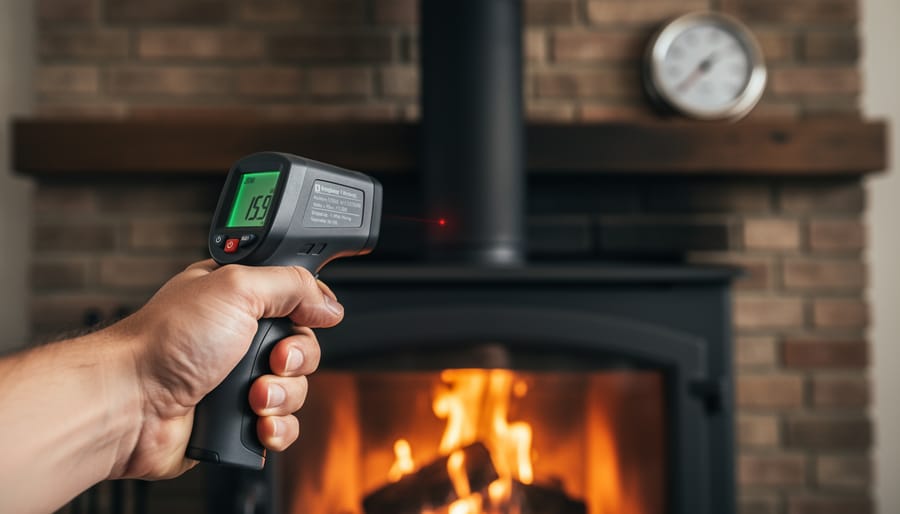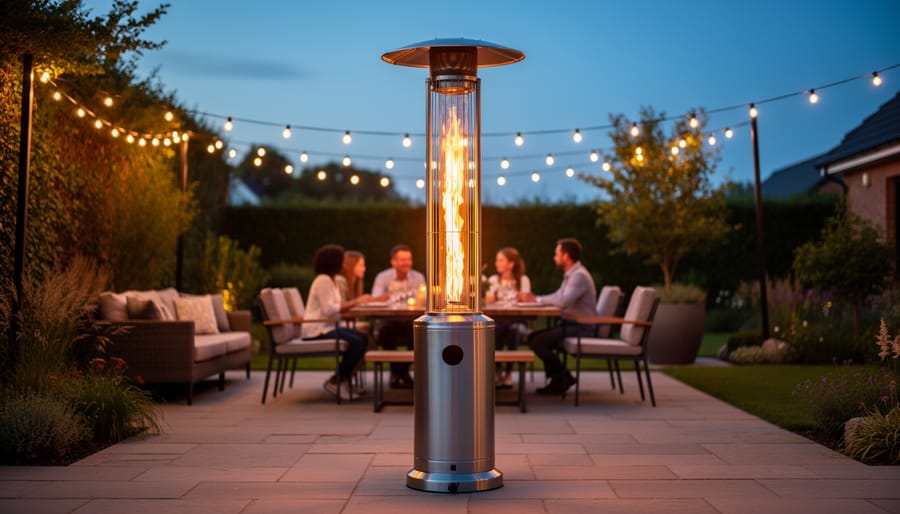Choose a wireless meat thermometer with a range of at least 300 feet to monitor your grilling from the comfort of your indoor fireplace or outdoor fire pit seating area. Look for models featuring dual-probe technology that simultaneously tracks meat internal temperature and ambient grill temperature, eliminating guesswork whether you’re smoking brisket over hickory or searing steaks on your outdoor cooking setup.
Prioritize thermometers with smartphone connectivity through Bluetooth or Wi-Fi, allowing you to track cooking progress while entertaining guests around your backyard fire feature. The best models send custom alerts when meat reaches your target temperature, preventing you from constantly checking and losing precious heat from your grill or smoker.
Consider battery life and charging options as part of your eco-friendly outdoor cooking strategy. Rechargeable lithium batteries reduce waste compared to disposable options, and solar-compatible models align with sustainable heating and cooking practices. Premium wireless thermometers offer 20+ hours of continuous monitoring—essential for low-and-slow cooking sessions that complement the relaxed ambiance of outdoor entertaining.
Invest in weather-resistant models rated for outdoor use, especially if your cooking area near your fire pit or outdoor kitchen experiences varied conditions. Waterproof probes and heat-resistant construction ensure reliability across all cooking methods, from quick weeknight grilling to elaborate outdoor feasts that extend your living space beyond your home’s walls. The right wireless thermometer transforms outdoor cooking from stressful timing exercises into confident, precise culinary experiences.
What Makes Wireless Different from Regular Digital Thermometers

Range and Connectivity Features
When you’re cooking outdoors around your fire pit or outdoor fireplace, staying connected to your meat thermometer without being tethered to the grill transforms your entertaining experience. Understanding the connectivity options helps you choose the right tool for your backyard gatherings.
**Bluetooth vs WiFi: What’s the Difference?**
Bluetooth thermometers typically offer a range of 100-300 feet in open spaces, making them perfect for moving between your patio and kitchen. They connect directly to your smartphone without requiring internet access—simple, reliable, and energy-efficient. However, walls and obstacles can significantly reduce this range.
WiFi-enabled models connect through your home network, offering virtually unlimited range as long as you have internet access. You could monitor your brisket from the grocery store if needed! The trade-off? They consume more battery power and require initial WiFi setup, which some find less intuitive.
**Real-World Range Considerations**
For most backyard entertaining scenarios, Bluetooth proves entirely sufficient. If your outdoor living space sits within 150 feet of where you’ll be relaxing, you’ll maintain a solid connection. WiFi becomes valuable for longer smoking sessions when you might want to run errands or work inside while your meat cooks low and slow.
Consider your typical hosting style: intimate gatherings where you’re nearby favor Bluetooth’s simplicity, while extended smoking sessions or larger properties benefit from WiFi’s flexibility. Both technologies have advanced considerably, offering reliable performance that lets you focus on creating memorable moments around the fire rather than worrying about losing signal.
Battery Life Considerations
When you’re enjoying a long afternoon grilling by your outdoor fireplace or tending to a slow-cooked brisket, the last thing you want is your thermometer dying mid-cook. Most wireless digital meat thermometers run on standard AA or AAA batteries, typically lasting anywhere from 1,000 to 2,000 hours of active use—plenty for several grilling seasons. The transmitter unit usually consumes more power than the receiver, so keep spare batteries handy during extended cooking sessions.
For the environmentally conscious home cook, rechargeable options are increasingly available and worth considering. Many newer models feature built-in lithium-ion batteries with USB charging capabilities, eliminating the need for disposable batteries altogether. While these units may cost slightly more upfront, they reduce waste and save money over time—aligning perfectly with sustainable living practices.
Some thermometers include low-battery indicators on both transmitter and receiver units, giving you ample warning before power runs out. If you’re planning an all-day smoke session or multi-course outdoor feast, consider models with longer battery life or keep a portable power bank nearby for rechargeable units. This simple preparation ensures your wireless thermometer stays reliable throughout even your most ambitious outdoor cooking adventures, letting you focus on creating memorable meals around the fire.

Top Wireless Meat Thermometers Compared
Best Overall: Premium Options That Deliver
When you’re gathering friends and family around your outdoor fireplace or fire pit for those memorable evening cookouts, investing in a premium wireless meat thermometer transforms your grilling experience from guesswork to precision perfection. These top-tier options offer the reliability and features that serious outdoor cooking enthusiasts deserve.
The **MEATER Plus** stands out as a truly wireless solution with its completely probe-integrated design—no wires whatsoever. With a range of up to 165 feet, you can monitor your brisket or prime rib from the comfort of your patio seating area while enjoying the warmth of your outdoor fire feature. The guided cook system walks you through each step, making it perfect for both beginners and experienced pitmasters. Its rechargeable battery eliminates the waste of disposable batteries, aligning with eco-friendly heating and cooking practices.
For those seeking multi-probe capabilities, the **Inkbird IBT-4XS** delivers exceptional value in the premium category. With four probes monitoring simultaneously, you can track multiple cuts of meat or different grill zones while managing your fire. The impressive 500-foot Bluetooth range ensures you’ll stay connected even in larger outdoor spaces. Our ThermoPro vs Inkbird comparison explores how Inkbird’s accuracy and durability stack up against competitors.
The **FireBoard 2 Drive** represents the ultimate investment for serious outdoor cooks, featuring six probe channels and cloud connectivity for monitoring from anywhere. While it’s pricier, the ability to control your blower fan automatically makes it ideal for long smoking sessions by your outdoor fireplace. Check out our detailed Tappecue vs FireBoard analysis to see if this premium option suits your outdoor cooking setup.
Best Budget-Friendly Choice
Starting your outdoor cooking journey doesn’t mean breaking the bank. Several wireless meat thermometers deliver reliable performance at wallet-friendly prices, making them perfect companions for your backyard fire pit gatherings and outdoor fireplace cookouts.
The ThermoPro TP20 stands out as an exceptional budget choice, offering dual-probe monitoring and a wireless range up to 300 feet—plenty of distance to let you mingle with guests while your meat reaches perfection. When comparing features, check out our detailed TP20 vs TP22 breakdown to find which model suits your needs best. Both options provide preset temperature settings and large, easy-to-read displays without the premium price tag.
Another solid contender is the Inkbird IBT-4XS, which connects via Bluetooth to your smartphone and monitors up to four probes simultaneously. While its range is shorter than radio frequency models, it’s ideal for patio cooking where you’re staying relatively close to your fire feature.
These affordable options typically use standard AAA or AA batteries rather than rechargeable systems, which actually proves convenient—you’ll always have backup power on hand. They include essential features like programmable alerts, preset cooking modes, and countdown timers that make monitoring effortless.
Remember, budget-friendly doesn’t mean sacrificing accuracy or safety. These thermometers help prevent overcooking and ensure food safety, letting you focus on creating warm memories around the fire rather than worrying about dinner.
Best for Fire Pit and Outdoor Fireplace Cooking
Cooking around your fire pit or outdoor fireplace brings a primal satisfaction that indoor grilling simply can’t match. But monitoring meat temperatures while flames dance and heat radiates requires equipment that can handle these rugged conditions. The right wireless thermometer becomes your trusted companion for achieving perfectly cooked steaks, chicken, and roasts over open fire.
When selecting a wireless meat thermometer for fire pit cooking, durability stands as your first consideration. Look for models with heat-resistant probes rated to at least 700°F, as direct flame exposure and radiant heat from stone or brick can quickly damage standard thermometers. Stainless steel construction ensures longevity, especially when exposed to outdoor elements and occasional sparks.
The **ThermoPro TP25** excels in fire pit environments with its 500-foot wireless range, allowing you to tend to your fire while monitoring four different cuts of meat simultaneously. Its waterproof design withstands unexpected weather, making it ideal for year-round outdoor cooking enthusiasts. The large backlit display remains visible even as evening settles around your outdoor fireplace.
For those seeking premium performance, the **Meater Plus** offers a completely wire-free experience with its wireless probe design. This eliminates the challenge of running cables around fire features and reduces trip hazards. Its 165-foot Bluetooth range connects seamlessly to your smartphone, letting you enjoy the warmth of your fire without constant monitoring.
Battery life matters significantly for outdoor cooking sessions. Choose models with replaceable batteries or long-lasting rechargeable options to avoid mid-cook power failures. Some thermometers include solar charging capabilities, aligning with eco-friendly heating solutions that many outdoor fireplace enthusiasts embrace. This sustainable approach reduces waste while ensuring your thermometer stays ready for spontaneous cookouts around your backyard fire feature.
Key Features to Look for When Choosing Your Wireless Thermometer
Accuracy and Response Time
When you’re grilling steaks by your outdoor fireplace or smoking a brisket at your backyard fire pit, accuracy and response time can make the difference between a memorable meal and an overcooked disappointment. Quality wireless thermometers should read temperatures within ±1-2°F of actual, ensuring your meat reaches that perfect doneness every time.
Response time matters just as much as accuracy. Look for thermometers that update readings every 1-3 seconds—this quick feedback helps you catch temperature spikes before they ruin your cook. Premium models often respond even faster, updating in real-time as conditions change around your fire.
Here’s what to expect from quality wireless units: accuracy within ±1.5°F across a range of 32°F to 572°F, and response times under 3 seconds. Budget models might drift to ±4°F variance, which sounds small but can mean the difference between medium-rare and medium for that ribeye.
Consider thermometers with multiple probes too—they’re especially handy when you’re cooking different cuts simultaneously over your fire pit. Just ensure each probe maintains consistent accuracy. Reading reviews from fellow outdoor cooking enthusiasts helps verify whether manufacturers’ claims hold up during real-world grilling sessions in varying weather conditions.
Weather Resistance and Durability
When you’re cooking outdoors around your fire pit or outdoor fireplace, your wireless meat thermometer needs to stand up to the elements. Look for models with at least an IPX3 or IPX4 waterproof rating, which protects against splashing water and light rain—essential for those unexpected weather changes during your backyard gatherings.
Heat tolerance is equally crucial. Quality wireless thermometers feature probes rated for continuous temperatures up to 572°F, with many handling brief exposures even higher. The transmitter unit should remain safely positioned away from direct heat, but still needs heat-resistant housing to handle the ambient warmth from your cooking fire.
Construction quality matters tremendously for longevity. Stainless steel probes resist corrosion and clean easily, while sturdy ABS plastic housings protect the electronics from drops and bumps. Food-grade materials ensure safety, and sealed battery compartments prevent moisture damage during storage.
Consider thermometers with reinforced probe cables—braided stainless steel offers superior durability compared to standard silicone coating. These features might cost slightly more upfront, but they’ll save you from replacing a failed thermometer mid-cookout. Think of it as an investment in countless successful outdoor cooking experiences, making your outdoor entertaining space even more enjoyable and functional throughout the seasons.
Smart Features That Actually Matter
When choosing a wireless meat thermometer, focus on features that truly enhance your outdoor cooking experience rather than flashy add-ons you’ll rarely use. The best apps offer intuitive interfaces with preset temperature guides for various meats and doneness levels—perfect for when you’re hosting around the fire pit and want to ensure everyone’s steak is cooked just right.
Custom alerts are game-changers, letting you mingle with guests while your thermometer monitors the grill. Look for models that send notifications when meat reaches target temperatures or if the grill temperature drops unexpectedly. Multiple probe monitoring is genuinely useful for cooking different cuts simultaneously.
Battery efficiency matters more than you might think. Rechargeable units reduce waste and save money over time, aligning with eco-conscious outdoor living. Range is practical too—you’ll want at least 150 feet so you can step inside to grab drinks without losing connection.
Skip thermometers with overcomplicated features like recipe databases you’ll never browse or social media integration. Simple temperature graphs showing cooking progress? Helpful. Voice commands? Usually unnecessary. Focus on reliable connectivity, accurate readings, and straightforward alerts that keep you present with your guests.
How to Use Your Wireless Thermometer for Perfect Results
Proper Probe Placement Techniques
Getting accurate temperature readings starts with proper probe placement—think of it as finding the sweet spot in your meat, much like positioning logs perfectly in your fire pit for optimal heat distribution.
For thick cuts like roasts and whole poultry, insert the probe into the thickest part of the meat, avoiding bones, fat pockets, and gristle. Bone conducts heat differently and can give false readings. When checking poultry, aim for the innermost part of the thigh without touching bone—this area takes longest to cook and ensures your bird is safe throughout.
With steaks and chops, insert the probe horizontally through the side into the center. For ground meat patties or meatloaf, go straight down into the middle where heat penetrates last.
When grilling over your outdoor fireplace or fire pit, where wood fire temperatures can fluctuate, wireless probes truly shine. Position the probe before cooking begins—inserting it mid-cook releases precious juices and heat. Make sure the probe tip sits in the meat’s center, not poking through the other side where it’ll read air temperature instead.
For best results, angle your probe away from direct flame contact, which could damage the sensor or give inaccurate readings.
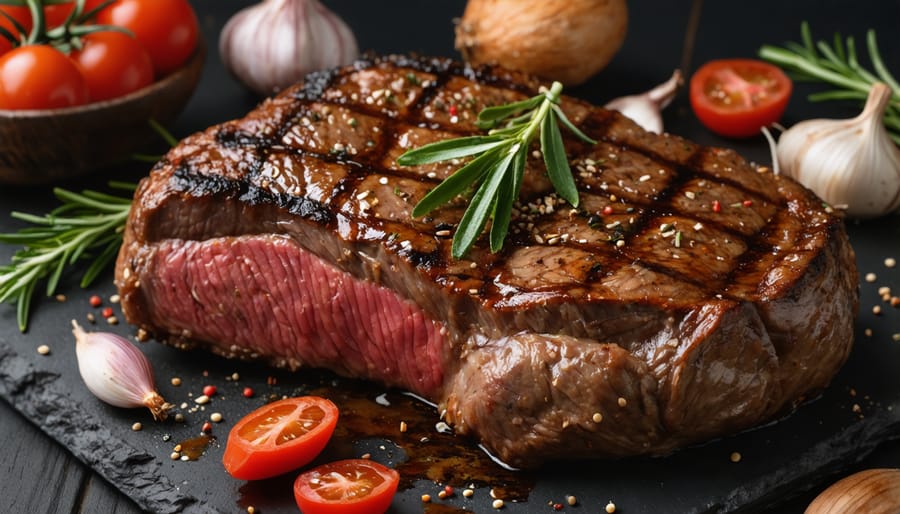
Avoiding Common Wireless Connection Issues
Wireless meat thermometers bring wonderful convenience to your outdoor cooking experience, but occasional connectivity hiccups can interrupt your fire-side gatherings. Let’s walk through some practical solutions to keep your wireless thermometer working smoothly.
**Signal interference** is the most common culprit. Metal surfaces, thick stone walls around your outdoor fireplace, and even other wireless devices can disrupt the signal between your thermometer’s probe and receiver. To minimize interference, position your receiver away from metal grill lids and stone structures. If you’re cooking near your fire pit, try placing the receiver on a wooden side table rather than directly on metal surfaces.
**Range limitations** become apparent when you’re trying to monitor your meal from inside the house while cooking outdoors. Most wireless thermometers advertise ranges of 100-300 feet, but walls and obstacles reduce this significantly. Test your thermometer’s actual range in your specific environment before relying on it during an important cookout. Consider positioning the receiver closer to a window facing your cooking area, or use a model with extended range capabilities if you frequently move between indoor and outdoor spaces.
For **outdoor cooking environments**, weather can affect performance. Keep your receiver dry and away from moisture, as dampness can weaken signals. Cold temperatures also drain batteries faster, so stock up on rechargeable batteries as an eco-friendly solution. Before each use, ensure fresh batteries are installed and that both units are properly synced according to your manufacturer’s instructions.
Safety Tips for Using Digital Thermometers Around Fire Features
Cooking around fire features creates a wonderful ambiance, but it’s essential to keep your wireless meat thermometer safe and functioning properly. These sophisticated devices enhance your outdoor cooking experience, yet they require thoughtful handling near open flames and high heat.
First and foremost, familiarize yourself with your thermometer’s heat tolerance limits. Most wireless transmitters can withstand temperatures up to 500-700°F, but direct flame contact should always be avoided. Keep the transmitter unit away from the immediate cooking zone—positioning it at least 12 inches from direct heat sources prevents damage to the electronics and battery. The receiver or your smartphone can be kept at a comfortable distance where you can monitor cooking progress without exposing it to heat.
Battery safety deserves special attention when using these devices around fire. High temperatures can cause batteries to overheat or even rupture, creating a hazardous situation. Store your thermometer in a cool, dry location when not in use, and remove batteries if you won’t be using it for extended periods. This practice not only extends battery life but also aligns with eco-friendly principles by reducing waste.
Proper cleaning maintains accuracy and longevity. Always wait until probes cool completely before handling or cleaning. Use warm soapy water for probes, avoiding submersion of electronic components. Never use abrasive cleaners that could damage sensors or protective coatings.
Regular equipment checks ensure reliable performance. Inspect probe wires for fraying or damage before each use, as compromised wiring near heat sources poses safety risks. Test your thermometer’s accuracy periodically using the ice water method, and replace worn components promptly. By maintaining your equipment properly, you’ll enjoy countless seasons of safe, successful outdoor cooking around your fire features.
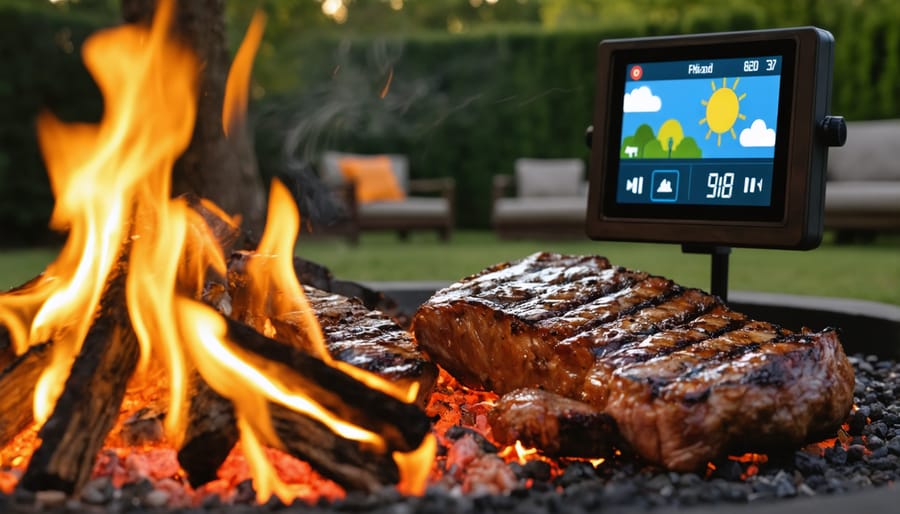
Gathering around your outdoor fireplace or fire pit creates those magical moments we cherish most—the crackle of flames, the warmth on a cool evening, and the joy of sharing perfectly cooked meals with loved ones. A wireless digital meat thermometer transforms these experiences by freeing you from constant grill-side monitoring. Instead of hovering over your food and missing the conversation, you can relax in your favorite chair, tend to the fire, or mingle with guests while your smartphone keeps you informed.
The beauty of wireless technology lies in how seamlessly it integrates into your outdoor lifestyle. Whether you’re slow-roasting over glowing embers or grilling steaks beside your fire feature, these thermometers ensure consistent results without disrupting the ambiance you’ve worked so hard to create. You maintain the peaceful atmosphere while technology works quietly in the background.
When choosing your wireless thermometer, consider your specific cooking style and entertaining habits. Frequent outdoor chefs who cook multiple proteins simultaneously will benefit from multi-probe models, while occasional grillers might find single-probe options perfectly adequate. Think about your typical range requirements—will you stay on the patio, or do you want monitoring freedom throughout your home?
Remember to factor in eco-friendly considerations like rechargeable batteries and energy-efficient Bluetooth connections. The right wireless thermometer becomes an extension of your outdoor cooking ritual, enhancing both your culinary success and the warm, welcoming environment that makes your outdoor space truly special.

